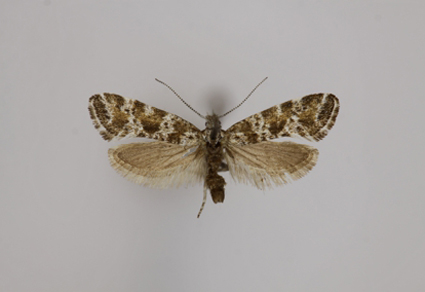Abstract
The genital morphology of the Lunakia alyssella (Klimesch, 1941) is redescribed. Additional details of both male and female genitalia are provided, supplemented with accompanying drawings. Anatomical evidence confirms that the genus Lunakia is distinct from the genus Eidophasia within the family Plutellidae. Males are characterized by long, curved appendages of the tegumen, and females by the antrum with a subgenital plate.
References
- Agassiz, D.J.L. (2013) Fauna Europaea: Plutellide. In: Karsholt, O. & van Nieukerken, E.J. (Eds.), Fauna Europaea: Lepidoptera, Moths. Fauna Europaea. Version 2017.06. Available from: https://fauna-eu.org/ (accessed 8 April 2021)
- Agassiz, D. & Friese, G. (1996) Plutellidae. In: Karsholt, O. & Razowski, J. (Eds.), The Lepidoptera of Europe, A Distributional Check List. Apollo Books, Stenstrup, pp. 59–60,
- deWaard, J.R., Ivanova, N.V., Hajibabaei, M. & Hebert, P.D.N. (2008) Assembling DNA Barcodes: Analytical Protocols. In: Cristofre, M. (Ed.), Methods in Molecular Biology: Environmental Genetics. Humana Press Inc., Totowa, New Jersey, pp. 275–293. https://doi.org/10.1007/978-1-59745-548-0_15
- Dugdale, J.S., Kristensen, N.P., Robinson, G.S. & Scoble, M.J. (1999) The Yponomeutoidea In: Kristensen N.P. (Ed.), Lepidoptera, Moths and Butterflies. Vol. 1. Evolution, Systematics and Biogeography, Handbook of Zoology 4. Arthropoda: Insecta 35. Walter de Gruyter, Berlin and New York, pp. 119–130.
- Huemer, P. & Sohn, J.-C. (2020) Eidophasia assmanni sp. nov. the first alpine representative of the genus detected in the Russian Altai Mountains (Lepidoptera, Plutellidae). ZooKeys, 959, 99–111. https://doi.org/10.3897/zookeys.959.54259
- Kaila, L. (1999) Phylogeny and classification of the Elachistidae s. s. (Lepidoptera: Gelechioidea). Systematic Entomology, 24, 139–169. https://doi.org/10.1046/j.1365-3113.1999.00069.x
- Klimesch, J. (1941) Eidophasia (Lunakia nov. subgen.) alyssella nov. spec. (Lep., Plutellidae). Zeitschrift des Wiener Entomologen- Vereines, 26 (5), 129–137.
- Klots, A.B. (1970) Lepidoptera. In: Tuxen, S.L. (Ed.), Taxonomist’s Glossary of genitalia in Insects. Skandinavian University Books, Munksgaard, Copenhagen, pp. 115–129.
- Kuznetsov, V.I. & Stekolnikov, A.A. (1976) Phylogenetic relationships between the superfamilies Psychoides, Tineoidea and Yponomeutoidea (Lepidoptera) in the light of the functional morphology of the male genitalia. Part 1. Functional morphology of the male genitalia. Entomological Reviev, 55, 19–29.
- Kyrki, J. (1984) The Yponomeutoidea: a reassessment of the the superfamily and its constituent suprageneric groups (Lepidoptera). Entomologica Scandinavica, 15, 71–84. https://doi.org/10.1163/187631284X00064
- Landry, J.-F. (1991) Systematic of Nearctic Scythrididae (Lepidoptera: Gelechioidea): phylogeny and classification of superspecific taxa, with a review of described species. Memoirs of the Entomological Society of Canada, 160, 1–341. https://doi.org/10.4039/entm123160fv
- Landry, J.-F. & Herbert, P.D.N. (2013) Plutella australiana (Lepidoptera), an overlooked diamondback moth revealed by DNA barcodes. ZooKeys, 327, 43–63. https://doi.org/10.3897/zookeys.327.5831
- Razowski, J. (2008) Tortricidae (Lepidoptera) of the Palaearctic Region. Vol. 1. General part and Tortricini. Frantisek Slamka, Kraków-Bratislava, 152 pp.


